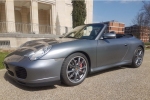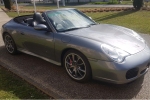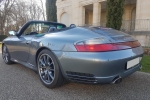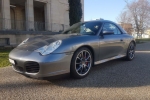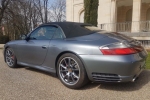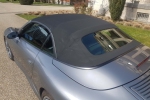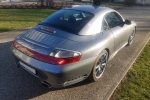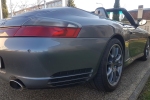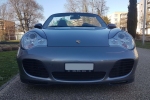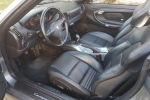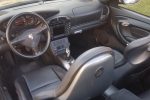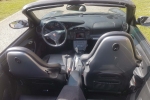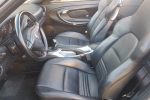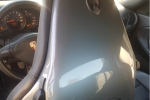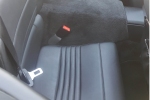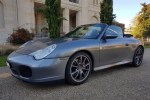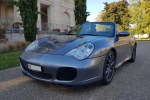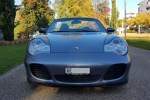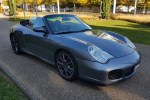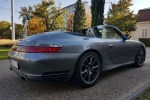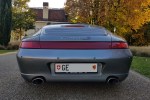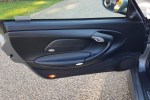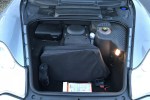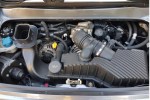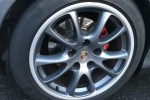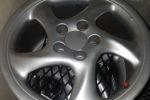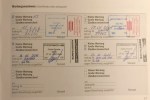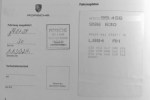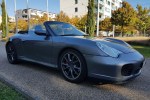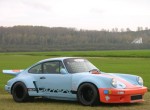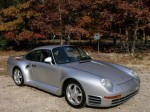Porsche 996 Carrera 4S Cabriolet
- 2004
- 79.917 km
- Manual
- CH title
- CH taxes paid
- Sold
This 2004 Porsche 996 Carrera 4S Convertible with color-coded aluminum hardtop is just one of a few dozen cars which left the factory with the highly desirable 6-speed manual gearbox.
Intended for the German market, this Mark II, or 996.2, was supplied new via Porsche dealership Niederrhein in Moers, Germany on the 29th of July 2004 to its first owner, resident in Switzerland. It has been regularly maintained since then, as evidenced by the original - and fully stamped - service booklet on file.
This Carrera 4S Cabriolet is finished in most attractive Porsche Seal Grey Metallic (paint code 6B4), which is complemented by a full black leather interior (code AH) and 18" color-coded forged alloy GT wheels (option 416).
Standard equipment of this Carrera 4S includes full automatic climate control, heat-insulating glass, electrically adjustable and heated rear-view mirrors, xenon lights, Porsche Stability Management PSM.2, Pioneer Multi Media Audio-system with accurate navigation, an electronic immobiliser, an alarm system with interior surveillance, an on-board computer, parking sensors and a foldable windbreak.
Generously equipped at the behest of a true Porsche aficionado, the car was further delivered with the following extra options:
| 288 | Headlamp washer |
| 342 | Seat heating |
| 375 | 2-way electrical sports seat, left |
| 376 | 2-way electrical sports seat, right |
| 416 | 18" 996.2 GT wheels |
| 440 | Windscreen antenna |
| 539 | Mechanical seat-height adjustment, left |
| 540 | Mechanical seat-height adjustment, right |
| XCZ | Short shifter |
| XLF | Sports exhaust system |
| XME | Centre console painted in car color |
| XPA | Thicker steering wheel |
| XSA | Sports seat backrests painted in car color |
| XDG | Wheels painted in body color, wheel caps with colored crest |
Its current owner, an enthusiastic Porsche collector and Club member, purchased the C4S in Geneva and has been its careful custodian for the past years. Indicating a modest 79,917 km, the car boasts the following main dealer Porsche service history.
| 2006 | 20,330 km | service at Porsche Center ASD in Zürich |
| 2008 | 39,962 km | service at Porsche Center ASD in Zürich |
| 2011 | 62,776 km | service at Porsche Center Sierre |
| 2015 | 76,886 km | service at Porsche Center Sierre |
The car comes with the factory hardtop including it's own trolley, a Porsche car cover as well as an extra set of alloy wheels to fit optional winter tires. The car will be serviced at a Porsche center, completely polished and will be supplied with a new control technique certificate (MOT) upon delivery.
This car is in perhaps the most driver-orientated specification: a four-wheel drive Carrera S fitted with the 6-speed manual gearbox. It steers, stops and turns with a level of communication and interactivity that puts most rivals to shame, and has a roof that operates efficiently at the press of a button to tuck itself away on the rear deck.
It's a car you can really enjoy driving: mechanically very robust, yet engineered to entertain. Simply changing gear is something to relish in the 911, while around corners it's poised, nimble and has steering that brims with feedback. Issues that often afflict rival convertibles such as scuttle shake have been almost entirely eradicated from the Porsche.
Low mileage Porsches are becoming increasingly interesting regarding investment potential with the 996 gathering inertia and this delightful car is definitely in that category.
On the 11th of September 1997, Porsche introduced its new 911-generation on the IAA Motor Show in Frankfurt. The 996 was a completely new concept from Porsche's design development team, led by Mr Harm Lagaay. It was the first 911 that used all new bodywork and did not carry over any significant component from the previous 993 model.
The body shape still resembles any earlier 911, but everything has changed. You can feel that the individual panels are less heavy than before, but this is progress and the engineers at Porsche always move forward. Open the driver's door and you will see a beautiful cabin architecture, two plus two seating, very good seats and a more relaxed driving environment.
The sleeker body features a more steeply raked windshield, a new headlight design as used on the Porsche Pan-America concept car and a completely re-designed interior space, aimed at the luxury market. The new car was far more practical too, with more space for touring, a roomier cabin and a structure that was 45% stiffer, yet, the 996 is 50 kg lighter than the outgoing 993 model.
Porsche set out to achieve a number of key objectives with this new model; it had to be faster, more drivable, more exploitable and more comfortable than any previous 911. Introduced first in rear wheel drive Carrera form, the thoroughly redesigned chassis had its wheelbase stretched to 2350 mm which, when combined with wider front and rear track, enabled the designers to provide vastly more cabin space.
Featuring MacPherson struts with coil springs and anti-roll bars front and rear, there were also bigger ventilated discs all round. New eighteen-inch alloy wheels were fitted as standard, with a number of alternative designs being available via the options list.
The most radical change for Germany's sports car since the 911 model's debut in 1963 however was the use of a water-cooled flat-six engine. Generations of 356 and 911 owners had associated Porsche with air-cooled engines, but with the 996, Porsche's signature model would be a water-cooled car in order to comply with more stringent emission and noise regulations.
The engine featured dual overhead camshafts, four valve alloy cylinder heads and variable valve timing and with a bore and stroke of 96 mm x 78 mm respectively, displacement was 3,387 cc. Sequential Bosch multi-point fuel injection and a compression ratio of 11.3:1 helped output up by 15 hp on the outgoing 993, 300 hp being available at 6800 rpm.
The 996 came with a choice of either a six-speed manual gearbox or Porsche's semi-automatic Tiptronic transmission, the performance figures for both versions unsurprisingly being faster than those of the 993. Indeed, top speed was 274 km/h whilst zero to 100 took a blistering 5.2 seconds (or six for the Tiptronic).
At the front, a cleaner and more rounded grille ran almost the width of the nose whilst light clusters similar in appearance to those of the Boxster gave Porsche's two models a strong family resemblance head on. Gently rounded front wings led up to a teardrop cabin that was immediately identifiable as pure Porsche 911, always shapely rear wings again incorporating Boxster-esque tail light clusters either side of the engine lid.
An electronically adjustable rear wing automatically rose at speeds in excess of 80 km/h, this aerofoil appearing remarkably unobtrusive when flush which adds to the 996's extremely clean profile. But despite these far-reaching tweaks to the original design, somehow Porsche retained enough distinctive traits to enable all but the most uneducated of bystanders to acknowledge that this is a Porsche 911.
A credit to both the modern designers and immortality of the original 911 concept then, the 996 is undoubtedly one of the most universally appealing designs around today. Just as significantly though, for almost the first time in its long and distinguished history, the 911 cabin got a thorough redesign with the arrival of this car.
A more contemporary, more shapely dash housed a new instrument binnacle and center console which led down to a markedly more substantial transmission tunnel, all a good deal more pleasing than the outgoing 993. Meanwhile, redesigned seats, door trim and a new three-spoke steering wheel all helped make the 996 cabin a much more habitable environment than any of its predecessors. Leather trim was standard along with air conditioning, regardless of a vehicles final market destination.
March 1998 saw a Cabriolet introduced, these new roadsters debuting what was perhaps the most pleasing Cabriolet bodywork of any Porsche 911. When lowered, the power hood all but disappeared below a hard body-color coded cover that, with a pleasing lack of canvas, helped it mimic the look of Porsche's 356 B Roadster.
The Carrera Coupe and Cabriolet were joined in July 1998 by a four-wheel drive version; this new model incorporating highly sophisticated anti-skid control by linking the ABS, ASR traction control and ABD automatic brake differential to create Porsche Stability Management PSM.
Governed electronically, PSM was programmed to recognize when the limits of the Carrera 4 had been exceeded by taking inputs from individual wheel speeds, acceleration and deceleration to act as a safety net although one that in no way intrudes on the essential 911 experience.
Meanwhile, derived from the viscous clutch four-wheel drive system employed on the 993, torque is split from front to rear, varying by between 5% and 40% depending upon conditions, driving characteristics and, in particular, any loss of traction through the front wheels. Weighing in 55 kg heavier than the Carrera, the Carrera 4 posted identical performance figures to its two-wheel drive sibling, 100 coming up in 5.2 seconds while top speed remained 274 km/h.
In response to customer demand, the four-wheel drive Carrera 4S was introduced in 2003 fitted as standard with many options including a wider turbo-style body and wheels, lowered suspension, and a sports exhaust coupled to the 3.6-liter engine which developed 320 hp @6800 rpm and 273 lb/ft torque. Aided by the inclusion of Variocam plus which improved power delivery through the range, the car was capable of 0-100 in 5 seconds and a top speed of 280 km/h.
As far as equipment is concerned, Porsche leaves the exclusive position of the Carrera 4S in no doubt, placing it very close to the 911 Turbo. This means standard equipment including not only automatic air conditioning, heat-insulating glass, electric window lifts, electrically adjustable and heated rear-view mirrors, central locking, an electronic immobiliser, an alarm system complete with interior surveillance, and an on-board computer, but also other features and signs of distinction.
Then, of course, there is four-wheel drive and Porsche Stability Management PSM, special 18-inch wheels in Turbo design and 295/30 ZR 18 rear tyres, a brake system increased in size, red brake callipers, metallic paintwork, an audio system with sound package, electrically adjustable seats with a position memory function and all leather upholstery and trim.
Typically Porsche, these cars are efficient and strong, characteristics that have always been evident in all 911 - making the description - an everyday super car - just as relevant today as its always has been.
“ your classic auto specialist; world-wide collector car expertise ”
We buy, sell, broker, locate, consign and appraise exceptional classic, sports and collector automobiles, arrange transport, customs formalities and registration.
Jaguar, Ferrari and Maserati expertise, though our collection includes a wide variety of other superior antique, vintage, prewar and race cars.
Contact us when you are serious about owning or selling a fine classic motor car or motorcycle. Geneva, Switzerland-based, we serve clients world-wide.
Chemin des Tulipiers | 1208 | Geneva | Switzerland | +41 (0) 787.055.745
